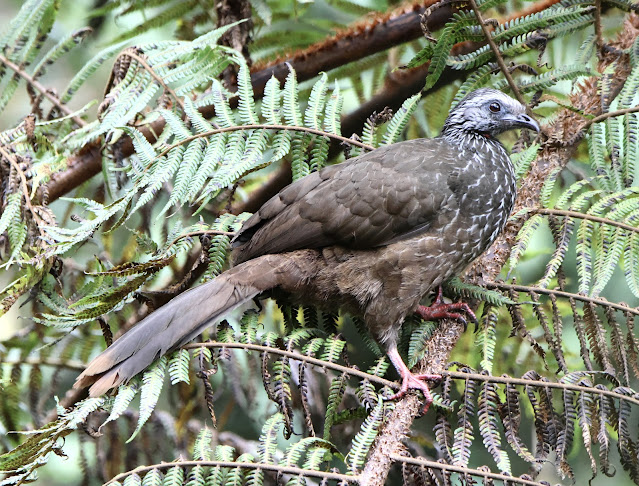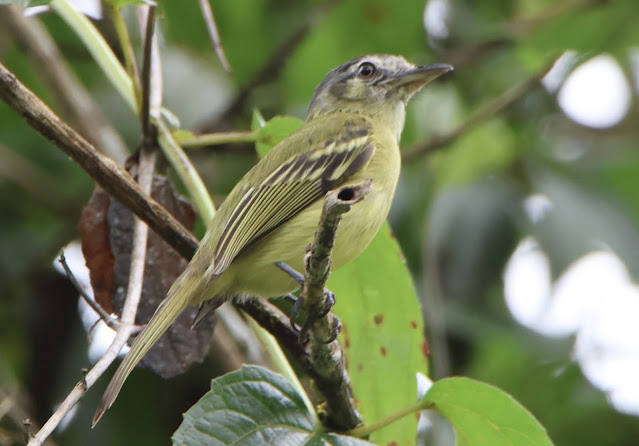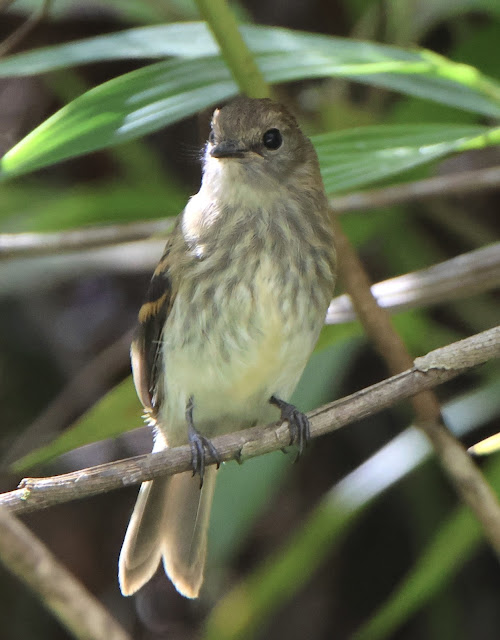Another birding trip is in the books. Another fun time for two Oregonians.
Four years ago I had joined a few others for a birding trip to Oaxaca, Mexico, where I met Eric Clough from Coos Bay, and we stayed in touch ever since. Eric is recently retired and has an interest in Latin America, so I suggested he consider coming to S Ecuador. He was interested and just needed to figure out convenient dates. He asked about bringing a friend Barb Taylor, also from Coos Bay, to which I was happy to oblige.
They embarked upon a series of 4 flights, ending up in Catamayo at 4:30 pm on April 30. Though tired from long flight times, they were up to birding near the airport where they ticked off Peruvian Meadowlarks, Chestnut-throated Seedeaters, Ecuadorian Ground Doves, a Peruvian Pygmy Owl and a few others.
It got dark about half way to my house, something I was not thrilled about because of the present road conditions. We all had hoped the rainy season would peter out, but late this afternoon it was more like a grand finale! My wife had texted me describing the worst torrent yet, and we saw the results as we neared Vilcabamba. There were small trees and debris here and there. We also came upon a boulder in the road, about half the size of my car. A few hundred meters down the Cucanama Road (where I live) a portion of the road was strewn with rocks, many the size of a footballs. It must have rained hard enough to result in a flood of sorts, a literal river on the road!. Almost unbelievable!

They got settled in, introductions with my wife over, then a meal. We were up and out on the back patio awakening with coffee and birds next morning. It was only natural to get off to a slow start, and when ready we drove to Cerro Mandango, the small sentinel of a mountain that overlooks Vilcabamba. We’d spent a couple hours here and tallied some 25 species. It was a good introduction to the local birds: Amazilea Hummer, Hook-billed Kites and Roadside Hawk, Chapman’s and Collared Antshrikes, Elegant Cresentchest, Rufous-browed Peppershrike, Black-and-White and Hepatic Tanagers, Gray-and-Gold Warbler and others. About halfway up the mountain Eric happened to look back toward town and noticed some large white birds catching a thermal. They turned out to be migrating Wood Storks! Twenty two of them. An amazing and out of place group, quite difficult to find anywhere in our area. There is simply no habitat for them anywhere near here.
From there we went across town to a road that goes up for a mile into a ravine. I have found this area excellent for birding in the past. However, about 300 meters in and we found the road had been demolished and replaced by a creek. The torrent the night before had rearranged it such that we would not be birding here. We did however find 2 Scrub Blackbirds, a small consolation.
So we went to bird part of the trail that goes along the river through town, finally finding Whooping Motmots. Other good finds were One-colored Becard, Yellow-tailed Oriole and Golden Grosbeak. After that we drove near my place where we went up a road that I’ve had good success in finding White-tailed Jays, but they were not around today. So we returned to my place by mid afternoon to rest and relax, getting ready for the next day. (We never would find a Jay, but the day after they left there was a pair at my house. Go figure!)
 |
| WHOOPING MOTMOT |
The results of the recent rain limited where I intended to take them, so I decided to go up Cerro Toledo, even though we’d be going there the following day with our guide John. We often see different birds each time we go there, and with John’s expertise the next day we would potentially see more anyway. And at least we’d not have to worry about road damage from rain. So we left my place at 6:30, picking up local birder Charlie for the day. The weather looked OK for lower down, but higher up looked quite iffy. We stopped here and there as we ascended and had fairly good success lower down. Some of the finds were Emerald Toucanette, Rufous-breasted Chat Tyrant, Three-banded Warblers, Slate-throated Redstarts, Azara’s and Line-cheeked Spintails, Smoke-colored Pewee, Turquoise Jays, Purple-throated Sunangel, White-bellied Woodstar, Mountain Wren, Lacrimose Tanagers, Chusquea Tapaculo and others.
 |
| Here is Eric having gotten a glimpse of the CHUSQUEA TAPACULO |
By the time we were about 2/3 of the way up, the clouds and rain began to set in, so we turned around and made our way back down the mountain. The Yangana River flows through the town of that same name and has a primitive road which parallels it. We parked about a quarter mile in as we opted to look for a White-capped Dipper, and had immediate success as soon as we got out of the car. We walked along the road for a ways, but all we saw was this green snake.
It was then back to my place to rest up and plan for a repeat the next day.
We picked up John about 6:30 and headed to Toledo again. The birding was pretty much opposite as the day before - slow, down low, but picking up, notably higher up. We did find a female Golden-rumped Euphonia down low, a nice addition to the list. Higher up, a little past where we turned around the day prior, we found a nice mixed flock which included Golden-crowned Tanagers and 2 Masked Mountain Tanagers, Spectacled Redstarts, Citrine Warblers, a Mouse-colored Thistletail, Glossy Flowerpiercers, and a Barred Fruiteater.
Up top it was cloudy and windy, but no rain. The visibility was poor, but we persisted and found a Neblina Metaltail and 2 Chestnut-winged Cinclodes, and a heard only Many-striped Canastero. It was miserable weather, and hardly worth pursuing birding, so we turned around and started back downhill. We ran into a few mixed flocks, and “finally” found some Orange-banded Flycatchers. Along with them was a White-banded Tyrannulet, Streaked Tuftedcheek, and Pearled Treerunner.
We pulled off at a wide spot, which in the past has had plenty of hummers. We did not notice any, and John began to meander down the road. I happened to look over the road and saw a raptor perched not far above John. When I put my bins on it, I was almost sure it was a White-throated Hawk, so I almost yelled at John telling him what was above him. But when our eyes met, he was putting his finger over his mouth, implying for me to pipe down as he had also laid eyes on it. It was indeed the species in question, obliging us with great views at our leisure. He stayed perched forever, so it seemed. This is a rare raptor in Ecuador and certainly a highlight of the tour, and a lifer for myself. For John and me, it was also camera time. We’d obtain great photos from as many angles as possible.
 |
| John and Bill taking photos |
Eventually the hawk took off, and so did we.
At one point John heard a Barred Fruiteater, so used playback, and this male obliged us in showing himself quite well. I’ve been wanting to get a decent picture of one for a long time, so it finally worked out.
 |
| MALE BARRED FRUITEATER |
Lower down we really tried hard to find a Green-tailed Trainbearer, but were not able. We also tried for a Gray-browed Brushfinch. We had one respond continually to playback, but after 20 minutes, it would not reveal himself, so we took off. But all in all it was a good day with 50+ species.
Here are some bird shots from Toledo:
 |
| Spectacled Restarts |
 |
| Citrine Warbler |
 |
| Masked Mountain Tanager |
 |
| Golden-Crowned Tanager |
 |
| Orange-banded Flycatcher |
 |
| White-throated Hawk |
The next day we were off at 5:30 en route south to Tapichalaca, again picking up Charlie for the 2 days we’d be gone. I had arranged for the guide Diego, who has pointed out birds for us in the past. When we met him at the lodge, he said we’d be going to feed the Jocotoco Antpitta. It turned out that we’d be driving back up the road, parking the car, and hiking downhill some 200 meters to the new feeding station. They had offered us rubber boots, but 3 of us declined as we don’t really like the support they provide. After slogging down the trail I wish I would have worn them. Charlie ended up slipping and going down, so his pants got a little muddy. It only took about 5 minutes for an adult female and a juvenile to show up for the worms, certainly a nice treat and another highlight of the tour.
 |
| Adult Jocotoco Antpitta |
 |
| Immature Jocotoco Antpitta |
Back at the lodge we embarked on the loop trail around the mountain. It was misty and birds were few and far between, but we managed to crank out Rufous Spinetail, Yellow-breasted Chat Tyrant, Golden-plumed Parakeets, Smoky Bush-Tyrant, and a few others.
Near the end of the trail we came upon a mixed flock that included Glossy-black Thrush, Scarlet-bellied Mountain Tanagers, and Black-throated Tody Tyrants. The trail ends at the highway where you need to walk back downhill at least a half mile to the lodge, and upon reaching this road were a few Gray-headed Bush Tanagers and a rare Red-hooded Tanager. Along the road was a Buff-breasted Mountain Tanager, a nice find.
 |
| Red-hooded Tanager |
 |
| Grass-green Tanager |
 |
| Beared Guan |
 |
| Smoky Bush-Tyrant |
After lunch we took Diego downhill with us to the small village of Valladolid. It might be of interest that many birders visit this area when near Tapichalaca, and of even more interest is that more birds have been recorded here vs Tapichalaca. There is a nice trail along the river which we walked. Birding was slow but before the rain we saw a pair each of Three-striped Warblers and Short-billed Chlorospingus, and a male Torrent Duck.
After the rain we walked the road which parallels the highway and tallied 4 species of hummers - Long-billed Starthroat, Andean Emerald, Little Woodstar and Crested Wiretail. Other birds here were Rufous-crowned Thornbird, Yellow-bellied Seedeater, Blue-necked and White-lined Tanagers, Speckled Chachalaca, Social Flycatchers, Maranon Thrushes, ……………..and lastly, the bird of the day, a lost and out of place Oriole Blackbird, a lifer even for Diego. These are a lowland, Amazonian bird, and what a single bird was doing so far away was puzzling.
 |
| Oriole Blackbird |
 |
| Female White-lined Tanager |
 |
| Common Tody Flycatcher |
From Valladolid we continued downhill to Palanda where, upon request, Diego recommended a small outdoor eatery where I had Cerveche, but I cannot remember what the others had. We then checked into the hotel and later on made plans for the morrow.
We departed at 6:30 a.m. a little further to the south, and then took the road that goes uphill where I had been 3 times in the past, a very good area to find the Chestnut-headed Cotinga. We only made it up about 1.5 miles due to low hanging clouds, but good fortune was with us. While we did not see the Cotinga, we did encounter a flock of Swallow Tanagers which distracted us for many minutes. Otherwise, Paradise Tanagers, Western Striolated Puffbird, White-winged Tanager, Western Fire-eye, Buff-breasted and Streaked Saltators, Yellow-tufted Woodpecker, Golden-faced Tyrannulet, Wing-barred Piprites, Yellow-bellied Elaenia, Ruddy Pigeon, Golden Tanager, Oliveaceous Greenlet, Green Jays, and a heard only Powerful Woodpecker were other nice finds.
 |
| Yellow-olive Flatbill |
 |
| Purple-throated Euphonia |
 |
| Red-headed Barbet |
 |
| Bronze-olive Euphonia |
 |
| Western Fire-eye |
 |
| Wing-barred Piprites |
The next 4 photos are by Charlie Renideo
 |
| Black-faced Dacnis |
 |
| Female Swallow Tanager |
 |
| Male Swallow Tanager |
 |
| Blue-winged Mountain Tanager |
We probably could have stayed on that hill a while longer, but decided to return to the main “road” where we continued south for a little bit. There was plenty of forest here and there, so we stopped and tallied Tawny-breasted Flycatcher, Oliveaceous Woodcreeper, Red-headed Barbet, Tropical Parula, Southern Rough-winged Swallows, and Bronze-olive Euphonia.
After an hour along that road, we decided to turn back north toward Vilcabamba, with plans to brunch with coffee at a small eatery near the Santa Florida Ruins. That eatery was closed, so we went to the ruins. After signing in, we walked around for a bit adding Flame-faced Tanager, Yellow-olive Flatbill, Orange-bellied and Purple-throated Euphonia to the list.
Once back in Valladolid we again walked the road paralleling the highway, as well as another road out of town, but as we did not see anything new, so continued north toward my place. It was cloudy for a few miles, but we eventually got above them and enjoyed the scenery while recrossing the continental divide, finally making it back home.
The next day was more or less a planned free day. Eric had been in touch with the local bike shop owner Chino about doing some volunteer work. Chino must have felt it best to ride bikes around a bit, and then take him for a jaunt on his motorcycle. They ended up taking lunch at the same time as Rosie, Barb and I, so the timing was good. Rosie had taken Barb to town to shop and show her around, but she misstepped on one of the many uneven sidewalks and sprained her ankle, cutting their day short. She called me to come pick her up, but……. it was not so bad that lunch at a restaurant was skipped. We all then came home and later on continued our game of dominoes - the 12 digit kind. We were now half way through the tour, getting ready to cross over to the east side of the Andes tomorrow, ready for whatever “adventures” awaited us.


























































